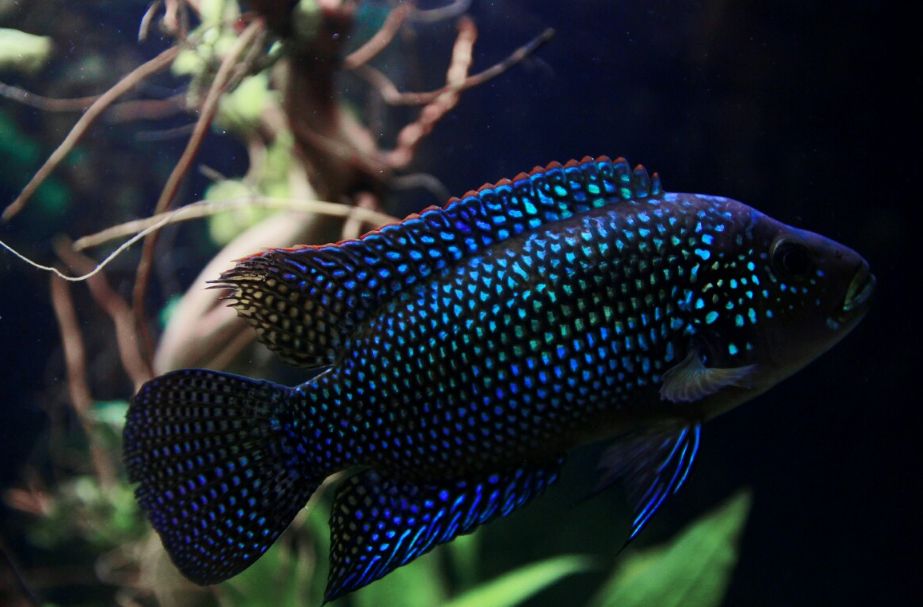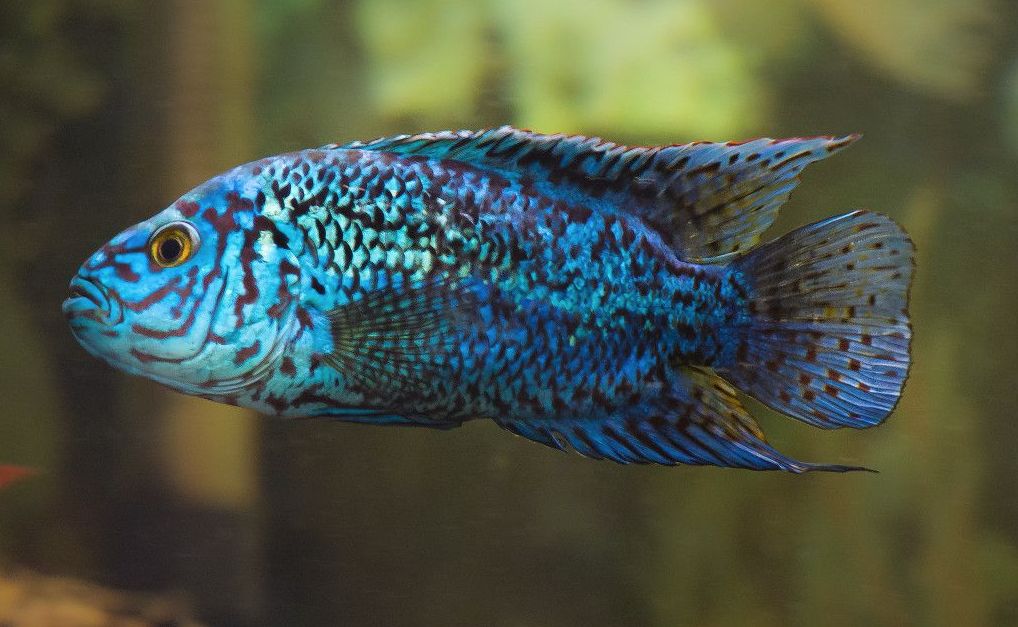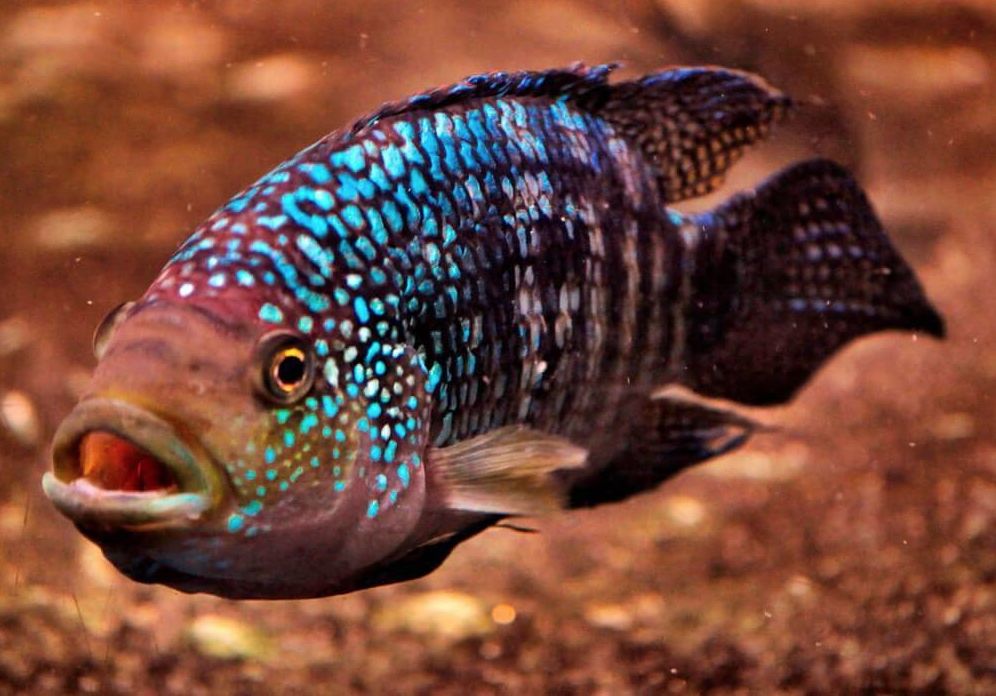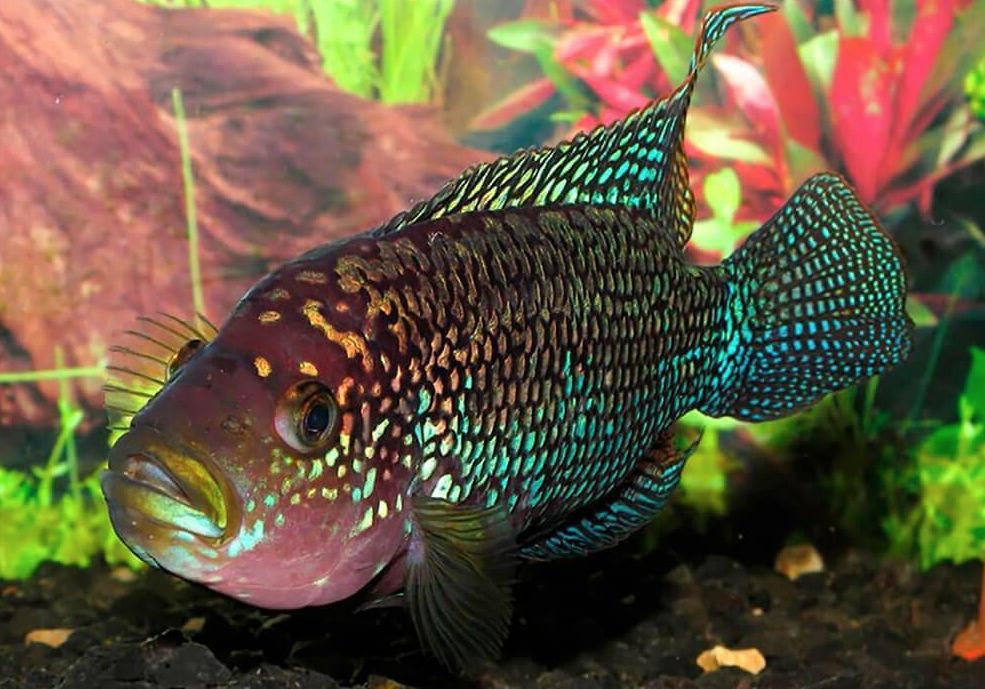The Jack Dempsey fish (lat. Rocio octofasciata) is a widely spread tank fish within North and Central America. Because of the fish’s congenital aggressiveness towards its tank mates, the USA aquarists have called it Jack Dempsey by the popular professional boxer’s name. They are named after the famous boxer Jack Dempsey due to their aggressive nature, especially during breeding and territorial defense.

Contents
Habitat in the wild
The Jack Dempsey fish, also known as Rocio octofasciata, is a popular freshwater fish species belonging to the cichlid family (Cichlidae). This family is known for its diverse and colorful species, and they are widely distributed in various freshwater habitats around the world. Cichlids are especially common in Africa, Central and South America, and some parts of Asia.
The first scientific description of the genus was made in 1903, and it received the Latin name Heros octofasciatus. The small Mexican river Rio-Sarabia flowing along Oaxaca and Veracruz states border was mentioned as the place where the fish was caught. In 1909 a similar kind was described, and it received the name Cichlasoma biocellatum. The fish species said to be caught in Rio-Negro, near Manaus (Brazil), were used as a scientific background for the description.
It looked like the fish habitat spanned a huge territory with a drastically different living environment.
However, it turned out that the fish habitat is limited to the waters of Central America. Moreover, modern researchers haven’t found any morphologically similar cichlids in Rio-Negro up to now. It is more likely that there was a mistake when describing the genus habitat.
A Mexican ichthyologist Juan Schmitter-Soto clarified this mess about the fish generic assignment by publishing his scientific research in 2007. In it, he described a new kind, Rocio, with type-species Rocio octofasciata, and also two new fish kinds, Rocio gemmata, and Rocio ocotal, that was endemic in Laguna Ocotal (State of Chiapas) and small lakes in the North-East of Yucatán.
Fish is native to Central America Atlantic hillside waters. It widely inhabits the area from the Ulua river (Honduras) to the Papaloapan river (South of Mexico). The fish may also be encountered in Guatemala, the Belize region. Fish was artificially settled into the waters in the USA South (in the state of Florida and some other areas close to the Gulf of Mexico) and Thailand waters.
The species has got Rocio’s name by the name of its describer’s wife; in Spanish, “Rocio” means “dew” and indicates the presence of sparklet-spots in the fish coloring. The specific name of the fish “octofasciata” comes from Latin words “octo” (eight) and “fascia” (a belt or a stripe), and it is translated as “eight-striped.” In fact, the fish has definitely more than eight stripes on its body.
Shallow rivers with clean water and small spring-fed lakes are the biotopes more common habitat for this fish. However, this species may also be encountered in low flow and even slough waters, which quite often have a soft muddy bottom. The fish has become naturalized in the USA. It quite often inhabits plant-filled channels and water furrows with a muddy or sandy bottom.
Description
Body coloring is olive-drab, and when the fish is angry or during its spawning period, it gets much darker and becomes almost black. Each scale of the fish body, its opercles, and fins have some sparkling spots on them, which depending on light and the fish state, can seem blue, cyan, or golden.
Female fish is colored less brightly. Juveniles have stripes on their bodies, but they aren’t very clear, and there are more than eight of them. Usually, there are ten or even eleven. The adult fish has some signs of these stripes on its forehead, back, and abdomen, but rich colored adult males have these stripes only on their foreheads.
There are some eyespots on the fish’s body sides and tail, which are rather clearly seen on the juvenile’s body and barely seen on the adult fish body. Iris is gray with some bronzy tint. The fish dorsal is red-edged.
Electric blue Jack Dempsey
There is also a blue-colored fish species – it’s widely known as «Blue jack Dempsey» or «Electric blue Jack Dempsey». The Electric Blue Jack Dempsey (EBJD) is a striking and highly sought-after variant of the Jack Dempsey fish (Rocio octofasciata). Unlike the standard Jack Dempsey, which exhibits earthy tones and spots, the Electric Blue Jack Dempsey boasts a vibrant electric blue coloration, making it a standout in any aquarium.
From hearsay, this unusual kind of Rocio octofasciata is considered to appear as a result of breeding with some other cichlid species, just like flowerhorn appeared. However, another point of view is considered as more convincing, that this bright blue variation of fish is one of the latest and the most impressive genetic mutations that are observed among tank fishes. Such variation is much more seldom seen since to obtain it, you have to be good at genetics, and some bright-colored and high-quality breeders are required for this.

Are Jack Dempsey fish aggressive?
Yes, Jack Dempsey fish (Rocio octofasciata) are known to be aggressive, especially during certain situations. They can be territorial and aggressive towards other fish, particularly during breeding or when they feel their territory is threatened.
To manage aggression in a Jack Dempsey aquarium, consider the following tips:
- Provide ample space and hiding spots: A well-decorated tank with plenty of hiding spots and caves can help reduce stress and aggression among the fish.
- Choose appropriate tank mates: Select tank mates that are compatible with the Jack Dempsey’s aggressive nature. Avoid housing them with very peaceful or slow-moving fish.
- Avoid overcrowding: Overcrowding can lead to increased stress and territorial disputes among fish. Adequate space is essential to minimize aggression.
- Monitor water quality: Poor water conditions can contribute to stress and potentially exacerbate aggressive behavior. Maintain good water quality through regular water changes and proper filtration.
- Observe and separate if necessary: Keep a close eye on the behavior of the fish. If any individual becomes overly aggressive or starts causing harm to others, it may need to be separated to avoid injury to other tank inhabitants.
By providing a suitable environment and taking appropriate measures, it is possible to manage the aggression of Jack Dempsey fish and create a harmonious community tank.
How big do Jack Dempseys get?
Jack Dempsey fish is a middle-sized Cichlasoma species. Male size is up to 21 cm long (8.27 inches), the female is up to 17 cm long (6.69 inches). However, in the wild, the male isn’t more than 12-15 cm long (4,72-5,91 inch). However, it’s essential to note that the actual size of an individual Jack Dempsey can be influenced by various factors, including genetics, diet, water quality, and the size of the tank they are kept in.
How long do Jack Dempsey fish live?
With proper care and a suitable environment, Jack Dempsey fish can live for approximately 8 to 10 years on average. However, their lifespan can vary depending on factors such as genetics, water quality, diet, and overall living conditions.
Providing a spacious aquarium with good water quality, a balanced diet, and regular maintenance can help ensure that your Jack Dempsey fish lives a healthy and happy life. Additionally, avoiding overcrowding and providing suitable tank mates can reduce stress and increase their chances of living a full lifespan. Always strive to meet their specific care requirements to maximize their longevity.
| Characteristic | Description |
|---|---|
| Scientific Name | Rocio octofasciata |
| Common Name | Jack Dempsey fish |
| Family | Cichlidae |
| Origin | Central America (Mexico, Honduras, Guatemala, Belize) |
| Habitat | Freshwater rivers and streams |
| Size | Up to 10-15 inches (25-38 cm) |
| Lifespan | 8-10 years (with proper care) |
| Temperament | Can be territorial and aggressive |
| Color | Metallic blue-green body with iridescent scales |
| Markings | Vibrant spots and stripes |
| Diet | Omnivorous (eats both plant matter and small animals) |
| Tank Size | Minimum 55-gallon tank for one adult fish |
| Tank Setup | Plenty of hiding places, caves, and open swimming space |
| Water Parameters | pH: 6.5-7.5, Temperature: 72-86°F (22-30°C) |
| Compatibility | Can be aggressive towards other fish, especially during breeding |
| Breeding | Egg-layers, both parents care for the fry |
| Special Considerations | Requires regular maintenance and water quality checks |
Difficulties in keeping
It’s quite simple to take care of fish since it’s not demanding, so the beginners can keep it.
However, you have to keep in mind that this is an aggressive fish that gets on well with other cichlid species while it’s young, but as the fish grows, it becomes more and more aggressive, so then it’s desirable to keep it without any other tank mates or only with large fishes.

Care and keeping in a tank
As a majority of Central America cichlids, Jack Dempsey fish doesn’t have any special requirements for the tank conditions. Nevertheless, the tank water should be clean, i.e., with zero ammonia and nitrite levels, and nitrate concentration shouldn’t exceed 40 mg/l. Nowadays, all these can be reached through strong biofiltration and regular water renew.
This species often inhabits rather poor conditions due to their careless owners and seems to show rather high vitality. However, this plainness is rather nominal. Young fish can inhabit tank water polluted with nitrogen compounds. However, very few of the fish live to the age of 4 years old. The negative influence of toxic substances accumulates, and then when the fish becomes an adult, it shows in the form of hexamitiasis and other diseases.
Meanwhile, provided with proper care, Jack Dempsey lifespan in a tank is about ten years and more. Except for poor quality water, other factors such as improper diet, frequent spawning, and stress influence its lifespan.
Tank size
The tank size for Jack Dempsey fish (Rocio octofasciata) depends on various factors, including the number of fish you plan to keep and the size of the fish. Jack Dempseys can grow to be around 10 inches (25 centimeters) in length, and they are known to be territorial and somewhat aggressive, especially during breeding or when they feel threatened.
For a single adult Jack Dempsey, a minimum tank size of 55 gallons is recommended. This provides enough space for the fish to swim, establish territories, and reduce aggression towards tank mates. If you plan to keep more than one Jack Dempsey in the same tank, you’ll need a larger tank to accommodate their territorial behavior.
Tank size capacity should start from 400 liters (104 gallons) for a couple of adult fish. In fact, this species aggressiveness, to a large extent, depends on the fish tank size. In small tanks (up to 250 liters or 66,04 gallons), an adult couple, as a rule, can’t stand any tank mates around unless it is some catfish or very small fish and juveniles.
In small tanks also there may be fights between the fish, male and female. If this happens, you should immediately take the female fish away from the tank. Keeping the fish couple for 3-6 month together and then for 1.5-3 month or more apart is considered to be ok if you keep the fish couple in a small tank (in a big tank, the female just swims to its other side and usually the male doesn’t chase her).
Also, the fish isolation from each other is a way to decrease their spawning frequency since doing it too often isn’t healthy for the fish, especially for females.
Keep in mind that larger tanks with more space and hiding spots can help minimize stress and aggression among the fish. Proper tank setup, water quality, and suitable tank mates are essential for the well-being and overall health of the Jack Dempsey fish in a home aquarium.
Water parameters
Maintaining proper water parameters is crucial for the health and well-being of Jack Dempsey fish (Rocio octofasciata). These cichlids are native to Central America, and their natural habitats typically have specific water conditions. Here are the recommended water parameters for Jack Dempsey fish:
- Temperature: The ideal temperature range for Jack Dempsey fish is between 72 to 86°F (22 to 30°C). Keeping the water within this range provides a comfortable environment and supports their overall health. When the water temperature becomes lower than 24 °C (75,2 F), the fish tends to stay close to the heater. Therefore, we can consider water temperature 26–27 °C (78,8-80,6 F) as the optimal one.
- pH Level: Jack Dempseys prefer slightly acidic to neutral water conditions. The recommended pH range for these fish is around 6.5 to 7.5. It’s essential to avoid significant fluctuations in pH levels, as stability is crucial for their well-being.
- Water Hardness: Jack Dempsey fish can tolerate a moderate level of water hardness. The ideal range for water hardness (measured in degrees of dH) is between 8 to 12 dH. This range can help replicate their natural environment.
- Ammonia, Nitrite, and Nitrate Levels: Regularly test the water for ammonia, nitrite, and nitrate levels and ensure they are at safe levels. Ammonia and nitrite should be at 0 ppm (parts per million), as these are toxic to fish. Nitrate levels should be kept below 20-40 ppm, as high levels can be harmful over time.
- Filtration and Water Quality: High-quality filtration is essential for maintaining good water quality in the aquarium. Regular water changes, typically around 20-25% of the tank volume every 1-2 weeks, can help keep the water clean and stable.
It’s crucial to monitor these water parameters regularly using reliable test kits and make adjustments as needed to ensure a healthy and stable environment for your Jack Dempsey fish. Keeping the water clean and within the appropriate range for temperature, pH, and hardness will help reduce stress and maintain the overall well-being of these vibrant cichlids.
Tank setup: decorations and plants
When preparing a tank, you should foresee the presence of some shelters in it. Also, keep in mind that this fish doesn’t like bright light, and it’s more active during the half-light period.
However, the main warning when keeping Jack Dempsey in a decorated tank is the fish “vandalism” towards any tank plants. In general, it’s possible to put some plants in a tank, the fish doesn’t eat them, but it can harm them once it decides that the plants don’t belong here.
Diet
The fish, by its nature, is an ambush predator. In the wild, its main food consists of small fishes and various spineless species. This fish is a predator, so you should feed it with live feed: brine shrimp, blood worm, tubifex, though thawed and milled seafood will do as well.
Here are some common foods that make up a suitable Jack Dempsey diet:
- High-quality Pellets: High-quality, sinking pellets specifically formulated for cichlids should be the staple of their diet. Look for pellets that contain a good balance of proteins, fats, and essential nutrients.
- Live Foods: Jack Dempseys enjoy live foods, and these can be an excellent addition to their diet. Offer occasional treats of live foods such as brine shrimp, bloodworms, daphnia, or small insects. Live foods can be particularly beneficial during breeding, as they can stimulate the fish’s natural instincts.
- Frozen Foods: Frozen foods are a convenient alternative to live foods. You can feed them frozen brine shrimp, bloodworms, and other frozen foods available in pet stores. Make sure to thaw them before feeding.
- Flake Foods: High-quality flake foods formulated for cichlids can also be part of their diet. However, pellets are generally preferred as they sink and are less likely to be wasted.
- Vegetables: While primarily carnivorous, Jack Dempseys can also benefit from some plant matter in their diet. You can occasionally offer blanched or boiled vegetables like spinach, zucchini, or peas.
- Freeze-dried Foods: Freeze-dried foods, such as freeze-dried krill or worms, can be offered occasionally as a treat.
When feeding Jack Dempsey fish, it’s essential to avoid overfeeding, as this can lead to health issues and poor water quality. Feed them small amounts multiple times a day, and observe their behavior to gauge their appetite. Uneaten food should be promptly removed from the tank to maintain water quality.
Variety is key to providing a well-rounded diet for Jack Dempseys, so try to offer a mix of the foods mentioned above. Providing a balanced diet will help ensure that your Jack Dempsey fish remain healthy and vibrant.

Gender differences: male vs female
Male is larger, more deep-bodied, and brightly colored. The adult fish body is almost all covered with sparklets. The male genital papilla is an antrorse (it has the shape of a firing hammer), the female fish genital papilla looks like an upside-down blunted cone.
Another difference, but it’s not a 100% hall-mark, is cyan spots on the bottom side of the female fish opercles, which the male fish doesn’t have.
When buying juveniles, keep in mind that at about 3-4 months old, the female fish is quite often larger than the male one. So, in this case, you shouldn’t use the fish size to define its gender.
However, if you take some time to observe the fishes, you’ll be able to define it even when the fish is that young. Males from their early days start showing their territory dependence and protect their nookery by trying not to let other juveniles in it. When they become aggressive, their coloring gets darker than the female juveniles have.
When observing fish “teens,” you can define their gender by the male’s pointed dorsal and the rounded one the female has. However, later both the fish, male and female, have a pointed dorsal.
Tank mates
In spacious tanks, Jack Dempsey fish doesn’t show such aggression, as they may do in small capacity tanks. Therefore you can keep the fish together with other equal-sized cichlid species. In small tanks, fights between opposite-sex representatives are highly possible. At that, often, this is the female who initiates the fight despite its obvious loss in size group. If the male doesn’t take the challenge seriously, the more movable female can make a good trashing on him. If it comes to a real fight, the female gets injured badly. The only option to keep her alive is to put her into another tank.
It is possible to keep the fish harem – one male and several females. In this case, he can pay attention to each female in turns. When growing males together without females, later the males don’t show any aggression towards each other. However, exceptions are possible since, to a large extent, it depends on each fish’s temper.
In spacious tanks, the fish is less aggressive than in small ones, and it becomes possible to keep them together with other cichlids of equal size. These may be texas cichlid, salvin’s cichlid, red terror cichlid, oscar fish, jaguar cichlid, firemouth cichlid, convict cichlid.
However, experience has proven that it’s not a good idea. Since the presence of other cichlid kinds dampens natural fish behavior. The only exception is when all of them were raised together from the very beginning.
You shouldn’t keep Jack Dempsey fish with any small fishes (like guppies, platy, tiger barb, and harlequin rasboras) since they’ll be eventually eaten.
Breeding
In the wild, the fish becomes reproductive at about the age of 12 months. As for Jack Dempsey fish kept in a tank, they become reproductive at 6 months already.
When the fish “teens” are kept together in one tank, they create couples themselves. Forced formation of the fish couple may be rather troublesome since males are rather demanding in this respect. So, if you aim to create the fish couple, not for just one spawning, it’s better to let the male choose his mate on his own from several females “teens.”
This approach is obviously the optimal one in minimizing conflicts inside the fish couple since predetermined smaller and younger female fish has a more soft nature and behaves correspondingly. If the dominating female shows aggression and tries to hustle away another female, it’s better to take her away from the tank because there are high chances that the male fish will have to choose her.
Jack Dempsey fish performs pair spawning on a substrate. The fish may use different substrates such as large flat stone, flower pot, or some section of a tank bottom cleaned from the substrate.
There were also cases when fish, just like dwarf cichlids, laid their eggs inside their nookery. The fish digs the tank bottom all the time, creates parapets along the tank walls, and damages tank plants. It’s better to get a separate tank for spawning. If you have a sailfin pleco in the tank together with a couple, it’s advisable to take the catfish away from the tank for a while since it may eat the spawn or become the reason for fish fights.
It’s quite peculiar for them to take care of their juveniles, so you won’t need to perform any special actions like taking away ill eggs from the spawn or installing aeration near the nest. The fish do everything on their own. On the contrary, it’s better not to disturb the fish if it’s not necessary.
The eggs grow for 3-6 days (depending on the temperature and other parameters). The day before the eggs hatch, the fish parents take their eggs from the substrate into the pit they have dug in advance. Don’t let this confuse you and decide that the fish has eaten their eggs. There also may be several such pits. In this case, the fish hides their eggs several times a day from one pit to another. And if there’s no substrate in a tank, but there are some plants in pots – these will also do.
The larvae start feeding on their own about 4 days later. Start feed for them may be the following: brine shrimp nauplii or some artificial feed.
The parents split their responsibilities as for their spawn: the female takes care of the eggs, juveniles, and larvae, the male guards their territory. In the real-life, this is the reason for conflicts.
The female may get angry with the male one because he is taking care of the hatch too eagerly, or he is guarding the territory not thoroughly enough. In the worst-case scenario, this leads to the fight inside the fish couple and eating their eggs or larvae. That’s why it’s better to isolate the male right after the spawning is over or a bit later – when the juveniles start to swim since he will just make the female nervous with his clumsy actions. Therefore, if there’s no other fish in the spawning tank – there’s no need to protect it.